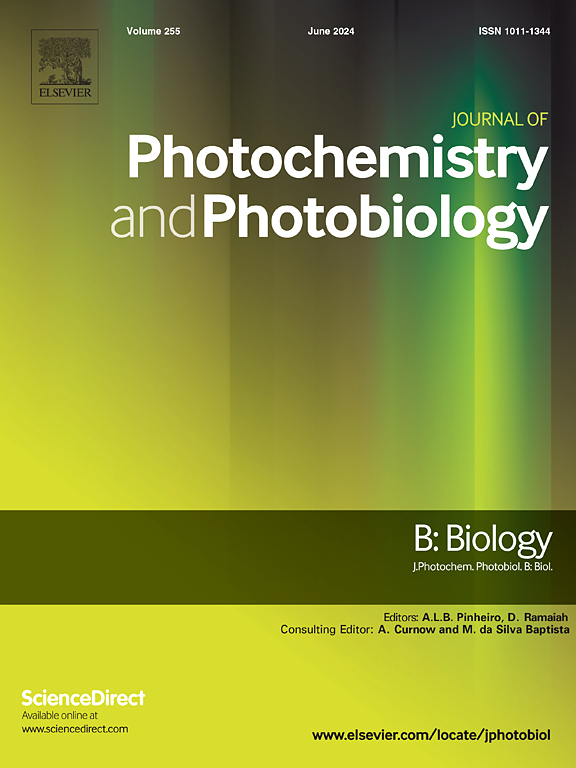Photodynamic inactivation of KPC-producing Klebsiella pneumoniae difficult-to-treat resistance (DTR) by a cationic porphyrin
IF 3.7
2区 生物学
Q2 BIOCHEMISTRY & MOLECULAR BIOLOGY
Journal of photochemistry and photobiology. B, Biology
Pub Date : 2025-02-20
DOI:10.1016/j.jphotobiol.2025.113133
引用次数: 0
Abstract
The global rise of difficult-to-treat resistance (DTR) bacteria, such as Klebsiella pneumoniae carbapenemase-producing Klebsiella pneumoniae (KPC-Kp), poses a critical challenge in controlling infections and curbing the spread of antimicrobial resistance genes. Antimicrobial photodynamic inactivation (aPDI) offers a promising alternative to traditional antimicrobials by effectively targeting extensively drug-resistant pathogens and mitigating antimicrobial resistance. This study investigated the in vitro photodynamic efficacy of the cationic porphyrin 5,10,15,20-tetrakis(1-methylpyridinium-4-yl)porphyrin (TMPyP) against planktonic cultures of KPC-Kp. The minimum effective concentration (MEC) of TMPyP for significant photodynamic activity was determined to be 0.8 μM under an irradiance of 314 ± 11 mW/cm2, delivering a total light dose of 189 J/cm2. At the same concentration, bacterial suspensions exposed to a lower irradiance of 107 ± 7 mW/cm2 achieved a > 99.997 % reduction in viability with a lethal light dose of 51.4 J/cm2. Scanning electron microscopy (SEM) revealed oxidative damage to the bacterial cell wall induced by aPDI. Hemolysis assays confirmed the safety of TMPyP, with no significant cytotoxicity or photocytotoxicity observed, and a selectivity index (SI) greater than 8, indicating a favorable therapeutic window. These findings underscore the potential of TMPyP-based aPDI as a therapeutic strategy to combat KPC-Kp infections. Further studies are warranted to explore its clinical applications and optimize treatment protocols for DTR bacterial infections.
阳离子卟啉对产kpc肺炎克雷伯菌难治性耐药(DTR)的光动力失活
产生碳青霉烯酶的肺炎克雷伯菌(Klebsiella pneumoniae, KPC-Kp)等难治性耐药(DTR)细菌在全球范围内的上升,对控制感染和遏制抗微生物药物耐药性基因的传播构成了重大挑战。抗菌素光动力失活(aPDI)通过有效靶向广泛耐药病原体和减轻抗菌素耐药性,为传统抗菌素提供了一种有希望的替代方案。本文研究了阳离子卟啉5,10,15,20-四(1-甲基吡啶-4-基)卟啉(TMPyP)对浮游培养物KPC-Kp的体外光动力作用。在辐照强度为314±11 mW/cm2,总光剂量为189 J/cm2的条件下,TMPyP具有显著光动力学活性的最小有效浓度(MEC)为0.8 μM。在相同浓度下,暴露于107±7 mW/cm2的较低辐照下的细菌悬浮液达到了>;致死光剂量为51.4 J/cm2时,存活率降低99.997%。扫描电镜(SEM)显示aPDI对细菌细胞壁的氧化损伤。溶血试验证实了TMPyP的安全性,没有观察到明显的细胞毒性或光细胞毒性,选择性指数(SI)大于8,表明有一个良好的治疗窗口。这些发现强调了基于tmpp的aPDI作为对抗KPC-Kp感染的治疗策略的潜力。需要进一步的研究来探索其临床应用,优化DTR细菌感染治疗方案。
本文章由计算机程序翻译,如有差异,请以英文原文为准。
求助全文
约1分钟内获得全文
求助全文
来源期刊
CiteScore
12.10
自引率
1.90%
发文量
161
审稿时长
37 days
期刊介绍:
The Journal of Photochemistry and Photobiology B: Biology provides a forum for the publication of papers relating to the various aspects of photobiology, as well as a means for communication in this multidisciplinary field.
The scope includes:
- Bioluminescence
- Chronobiology
- DNA repair
- Environmental photobiology
- Nanotechnology in photobiology
- Photocarcinogenesis
- Photochemistry of biomolecules
- Photodynamic therapy
- Photomedicine
- Photomorphogenesis
- Photomovement
- Photoreception
- Photosensitization
- Photosynthesis
- Phototechnology
- Spectroscopy of biological systems
- UV and visible radiation effects and vision.

 求助内容:
求助内容: 应助结果提醒方式:
应助结果提醒方式:


